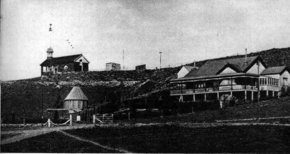 | |
| Alternative names | Johannesburg Observatory |
|---|---|
| Observatory code | 078 |
| Location | Observatory, Johannesburg, South Africa |
| Coordinates | 26°11′3″S 28°04′27″E / 26.18417°S 28.07417°E |
| Altitude | 1,808 metres (5,932 ft) |
| Established | 1903 |
| Closed | 1971 |
| Website | assa |

Union Observatory, also known as Transvaal Observatory, Republic Observatory and Johannesburg Observatory (078), is a defunct astronomical observatory in Johannesburg, South Africa that operated from 1903 to 1971. It is located on Observatory Ridge, the city's highest point at 1,808 metres altitude in the suburb Observatory.[1][2]
The observatory and its former annex, the § Leiden Southern Station, are known for the discovery of 6,000 double stars and for Proxima Centauri, made by astronomer Robert Innes. At the observatory, 578 identifications of minor planet were made, a record number at the time.[1] The Minor Planet Center credits the observatory as the site where 147 minor planets were discovered by astronomers Harry Wood, Cyril Jackson, Hendrik van Gent, Ernest Johnson, Ejnar Hertzsprung, Jacobus Bruwer and Joseph Churms (see § List of discovered minor planets).[3]
- ^ a b Cite error: The named reference
ASSA-newwas invoked but never defined (see the help page). - ^ Cite error: The named reference
ASSA-archive-fullwas invoked but never defined (see the help page). - ^ Cite error: The named reference
MPC-Discovererswas invoked but never defined (see the help page).
